I first interviewed Zoë Field of Field of Roses here on the Floret blog way back in 2016 when I wanted to learn more about the farmer-florist movement in New Zealand. I have long-admired Zoë from afar and am dying to visit her farm in person someday.
This past fall (spring in the Southern Hemisphere) Zoë released her first book, Lost & Found, and I was fortunate enough to get a copy to review in advance. Lost & Found is like nothing I’ve ever seen before—it’s like the seek-and-find books I loved as a kid, but made for flower lovers! It’s so wonderful to see Zoë’s unique perspective through her camera lens.
Today, I’m excited to publish a new interview with Zoë and get the opportunity to share about her work and wonderful book with you, which is a must-add to your flower library.
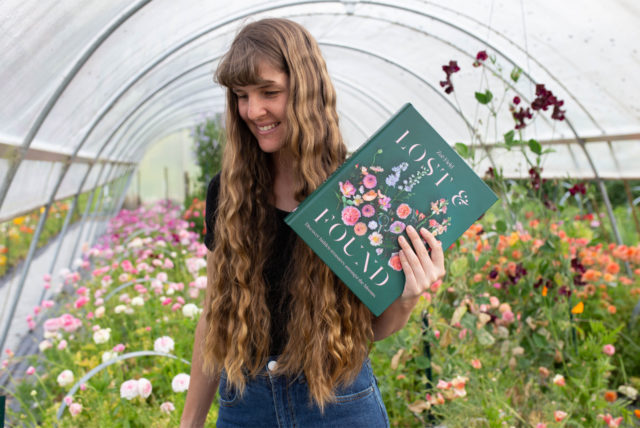 Thanks for joining us again Zoë, and congratulations on your new book! It’s been quite a while since we last interviewed you—can you give an update on how things have changed since we last spoke on the blog?
Thanks for joining us again Zoë, and congratulations on your new book! It’s been quite a while since we last interviewed you—can you give an update on how things have changed since we last spoke on the blog?
Thank you so much for inviting us back. Well, one thing hasn’t changed, it’s still just me and mum working away in the field. I would say the direction of our business has shifted from just supplying flowers wholesale to now creating with our flowers. Whether that be through our event work, local bouquets, workshops, or now our book. The farm is an ever-evolving story—it’s always a surprise the places it leads you.
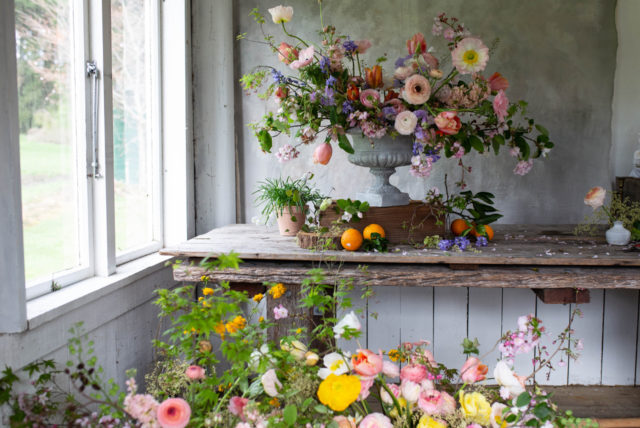
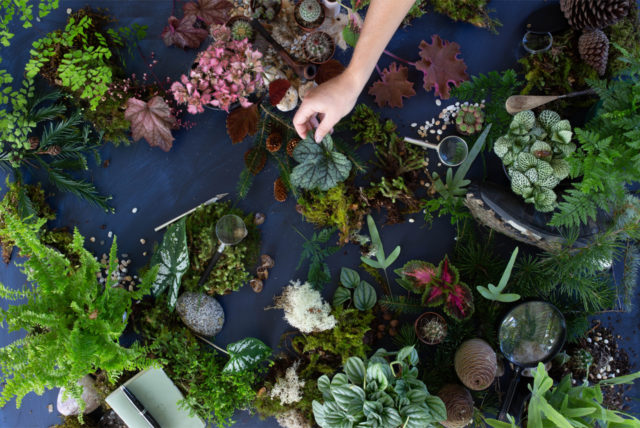 Lost & Found incorporates two of your biggest passions—flowers and photography—and is an absolute feast for the eyes! It’s such a joyous, playful book and it was fun to spy some Floret seed packages woven into a few of your stunning images—we appreciate the love! How did you come up with the concept? Did you enjoy seek-and-find books as a child?
Lost & Found incorporates two of your biggest passions—flowers and photography—and is an absolute feast for the eyes! It’s such a joyous, playful book and it was fun to spy some Floret seed packages woven into a few of your stunning images—we appreciate the love! How did you come up with the concept? Did you enjoy seek-and-find books as a child?
Yes, as a child I loved seek-and-find books. They inspired my imagination and play so much. I would get drawn into their worlds as I searched the pages. I wanted to recreate that very same joy I’d felt as a child but with a grown-up twist, incorporating my love of flowers and nature, but still holding onto that playfulness.
I think that the simple act of searching for objects has a way of slowing you down, as if walking through a garden, taking in every little detail. I think that’s the magic of this book. I imagined people revisiting the pages and each time finding something they may have overlooked, the page revealing itself more with each viewing.
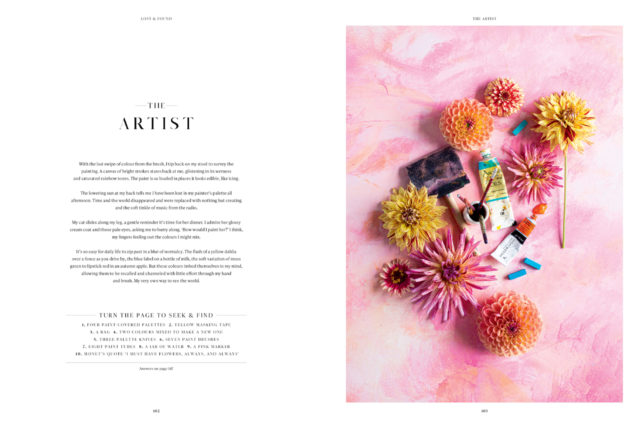
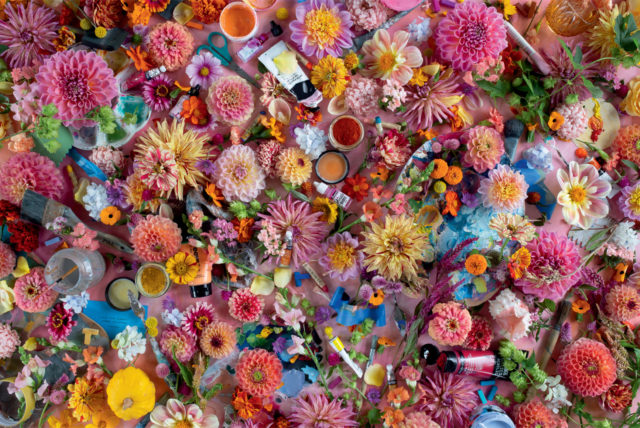 It seems like many of these “imagined creative characters” and their lovely vignettes are inspired by your own life. It’s so hard to choose, but I think “The Beekeeper” flat-lay is my favorite. Did you have each character in mind before you created the seek-and-find photo or did they reveal themselves in the creative process?
It seems like many of these “imagined creative characters” and their lovely vignettes are inspired by your own life. It’s so hard to choose, but I think “The Beekeeper” flat-lay is my favorite. Did you have each character in mind before you created the seek-and-find photo or did they reveal themselves in the creative process?
I had a list of characters, more than I needed. Many were inspired by my own life, others by fellow creatives around me, like the “The Beekeeper,” “The Artist,” “The Potter,” and “The Musician.” I would walk through the field and the flowers would start to reflect their stories.
The honey-toned roses for “The Beekeeper,” sepia chrysanthemums for “The Photographer,” fluffy peonies for “The Florist,” muddy bearded iris for “The Potter”—their worlds slowly revealing themselves bloom by bloom, in form, texture, and colour. It was very organic in that sense. We collaborated with the lovely Julie Atkinson-Dunn who would take each vignette and write a beautiful story inspired by it, adding another layer to each character.
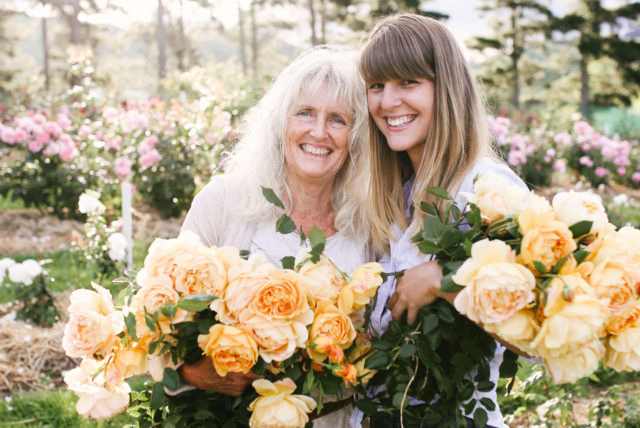
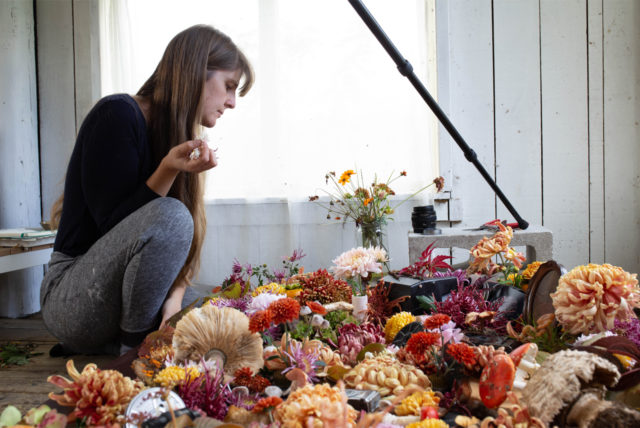 I know your flower farm and design studio Field of Roses is a true family affair. Was your mom Sue at all involved in the making of Lost & Found?
I know your flower farm and design studio Field of Roses is a true family affair. Was your mom Sue at all involved in the making of Lost & Found?
Mum was most definitely involved, she’s the sounding board for all my ideas. She’s great at helping to grow them, asking the right questions, and she sees things I so often miss. I would start laying out the flowers, weaving the objects in, flower by flower. I’d get as close to finished as I could and then I’d call out to her, “MUM!” She’d be somewhere in the field keeping things ticking along, usually weeding, that’s her favourite (literally). I needed her fresh eyes on it as we made the final adjustments. We were running back and forth from the field getting those last little bits until we were both happy.
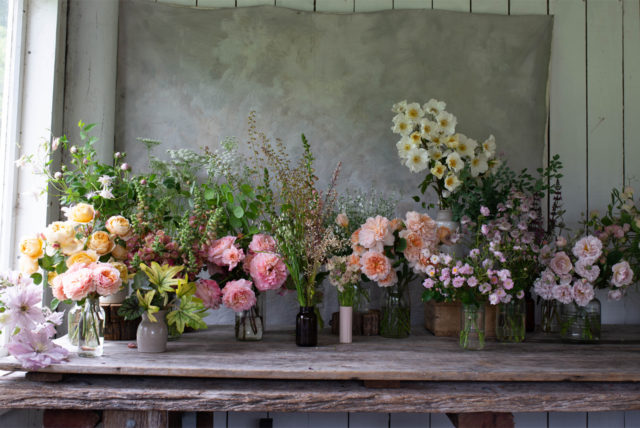
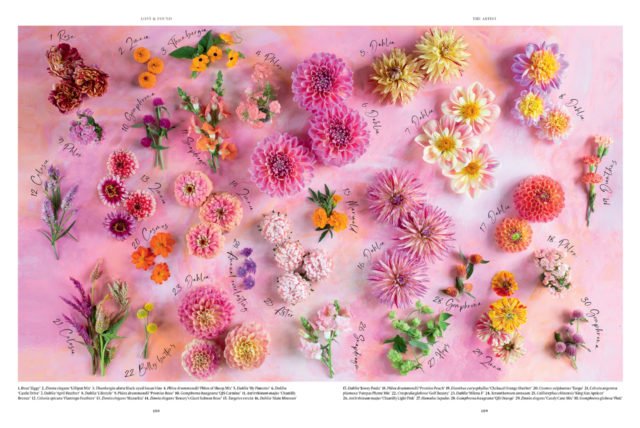 I adore all of the color palettes and the beautiful collections of flowers you showcase throughout the book. Do you have difficulty getting these unique varieties since you live in a more remote location? Can you share some of your favorite sources?
I adore all of the color palettes and the beautiful collections of flowers you showcase throughout the book. Do you have difficulty getting these unique varieties since you live in a more remote location? Can you share some of your favorite sources?
This is definitely a book that I could only do now after years of collecting plants from various places. It can be a real treasure hunt here in New Zealand, tracking down that elusive plant you’ve been eyeing in photos from the Northern Hemisphere. I would say it’s starting to become easier with more seed suppliers and nurseries catching onto the trends.
I will give a big shout-out to Sarah Hawkless of Emerden, who I have bought seeds and plants from over the years. She sources the most beautiful ranunculus, anemones, and cut flower seeds from overseas. I feel like she really helped change the flower landscape here, making it that much easier for us to get our hands on those special varieties that we could only ever dream about before.
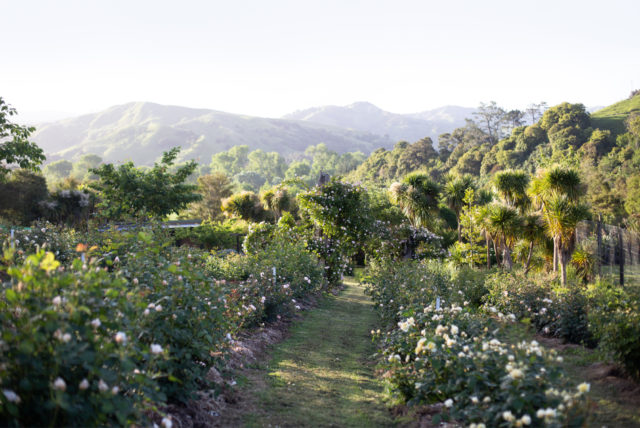
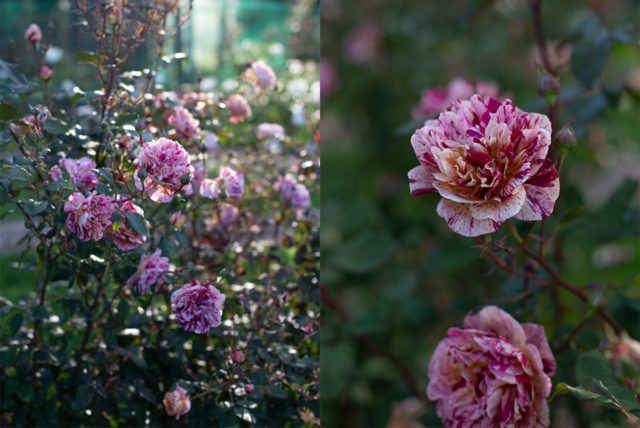 You’re in the thick of summer in New Zealand as we’re closing out winter here in the Northern Hemisphere. Have you made any discoveries this season that you’re excited about? I’m especially interested to hear if there are any new rose varieties you can’t live without!
You’re in the thick of summer in New Zealand as we’re closing out winter here in the Northern Hemisphere. Have you made any discoveries this season that you’re excited about? I’m especially interested to hear if there are any new rose varieties you can’t live without!
Over the winter, we pulled out lots of roses that were underperforming. I said we were downscaling, but we ended up using it as a good excuse to source more. I really want to have a beautiful collection of New Zealand-bred roses throughout the field, so I’m trialing a lot of new varieties from Matthews Roses. Bob Matthews is a renowned rose breeder here, and his plants are always the healthiest in our block.
It’s been a hard season for the roses, so I feel like my new additions didn’t quite get to shine like they normally would. But my all-time favourite of his roses so far is ‘Ziggy’ (pictured above), a multicoloured rose with a golden apricot base and flecks of burgundy and strawberry-red—you can really create some fun designs with it. I have a soft spot for anything with multicoloured flecks—roses, dahlias, zinnias—I love them all.
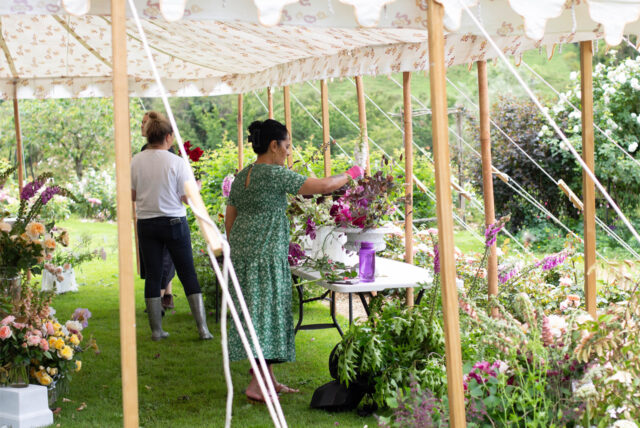
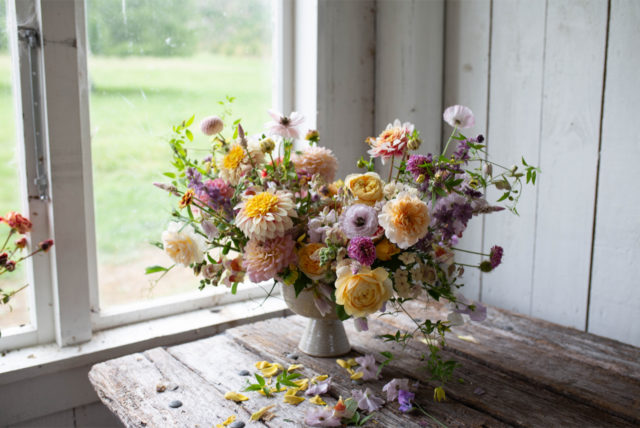 I saw on Instagram that you teamed up with Flora Forms for a Spring Urn Workshop that looked pretty magical! Can you tell us more about that experience and if you have any upcoming workshops people in your area might be able to attend?
I saw on Instagram that you teamed up with Flora Forms for a Spring Urn Workshop that looked pretty magical! Can you tell us more about that experience and if you have any upcoming workshops people in your area might be able to attend?
Yes, this season we collaborated on some workshops with Rhonda of Flora Forms, who has a farm about 20 minutes from us. We met at a flower farmer’s conference a few years back and have enjoyed working together ever since. I think all things are so much more fun when you collaborate, it’s the perfect recipe for ideas to flow.
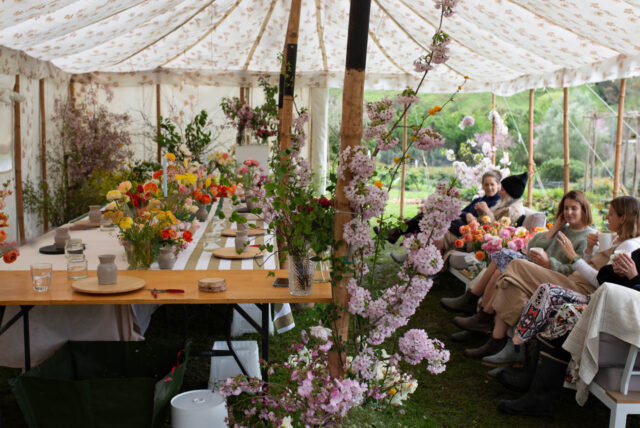 We pitch our second-hand Raj tent and fill it with flowers from both of our farms. Rhonda is a potter and makes the vessels, and mum is a great cook so she whips up a soulful meal for everyone. It’s a beautiful day, yet relaxed and down-to-earth, the perfect recharge.
We pitch our second-hand Raj tent and fill it with flowers from both of our farms. Rhonda is a potter and makes the vessels, and mum is a great cook so she whips up a soulful meal for everyone. It’s a beautiful day, yet relaxed and down-to-earth, the perfect recharge.
We had planned for more workshops this season but the weather has been against us, so we now have our eyes set on early Spring and are making plans for September.
Thank you so much, Zoë, for taking the time to share about what you’ve been up to and your beautiful new book with Floret readers. I am so excited that copies are finally available for us here in the states. I know that was quite the feat for you and your publisher and so many gardeners here will be grateful for your efforts.
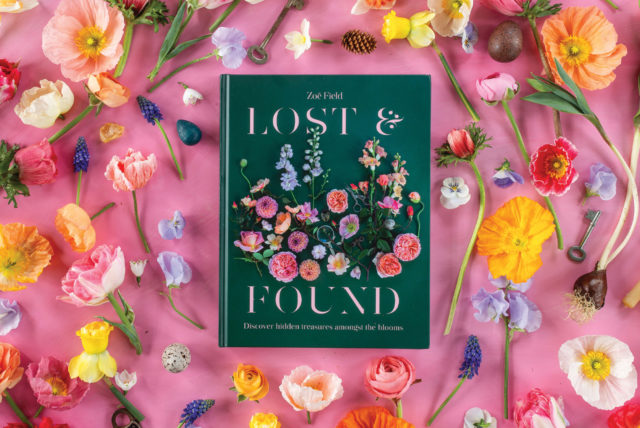 To celebrate the release of Zoë’s new book, Lost & Found, we’re giving away five copies. For a chance to win, simply post a comment below telling us what type of book you were most interested in as a child and how it’s helped shape who you are as an adult. Winners will be announced on March 7.
To celebrate the release of Zoë’s new book, Lost & Found, we’re giving away five copies. For a chance to win, simply post a comment below telling us what type of book you were most interested in as a child and how it’s helped shape who you are as an adult. Winners will be announced on March 7.
To learn more and connect with Zoë, be sure to visit her website and follow her on Instagram and Facebook. Lost & Found is available from Amazon, Barnes & Noble, or your favorite bookstore.
A huge congratulations to the giveaway winners: Camilla Herold, Erin M, Sarah Tatley, Jessica Marigold, and Jill Green
On February 12, tropical storm Gabrielle hit the North Island of New Zealand, causing gale-force winds, mudslides, and severe flooding which has displaced thousands of people in rural communities. We reached out to Zoë to see how we could help and here is her response.
Cyclone Gabrielle hit our region last week causing devastation to the Hawkes Bay, East Coast, and Northland regions of New Zealand. The scale of damage is beyond anything I have ever seen, so many have lost everything and many are still cut off with no access in or out. The images and stories coming out from these places are truly heartbreaking. Donations can be made to the Red Cross New Zealand Disaster fund or I have a link to a list of various organizations directly helping those in more rural communities.
As for our farm, we count ourselves lucky, our family is safe as is our flower field perched on the top of a hill, however, the river flats of our property were hit by flood waters. My incredible dad has been working hard, opening up road access, moving silt, and rebuilding broken fences and pipelines, we’d be lost without him. There is still a lot of work ahead but compared to others we are incredibly lucky and count our blessings.
Please note: If your comment doesn’t show up right away, sit tight; we have a spam filter that requires we approve comments before they are published.
Floret only lists companies and products that we love, use, and recommend. All opinions expressed here are our own and Floret does not offer sponsored content or accept money for editorial reviews. If you buy something using the retail links in this post, Floret may receive a small commission. Thank you for your support!

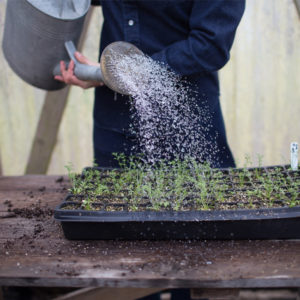

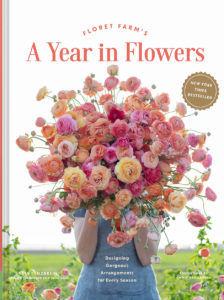
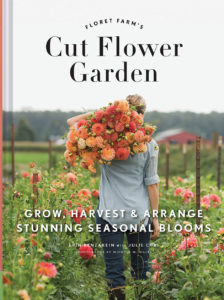


Judy on
Children’s books that were enchanting from cover to cover were my favorites. Many contained illustrations in watercolor pastels of ladybugs, flowers, bunnies, birds and a Princess with long long hair ..and perhaps a handsome Prince with a fiery horse. And on every page a new delightful surprise that represented joy, hope and love of our enchanting Earth